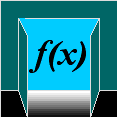Stony Brook UniversityMAT 123
|

|
 Index Index Course Description Course Description Teaching Staff, Office Hours Teaching Staff, Office Hours Syllabus and Schedule Syllabus and Schedule Homework Homework |
|---|
Stony Brook UniversityMAT 123
|

|
 Index Index Course Description Course Description Teaching Staff, Office Hours Teaching Staff, Office Hours Syllabus and Schedule Syllabus and Schedule Homework Homework |
|---|
The fundamental objects of study in mathematics are functions. The approach taken in MAT 123 is to present and analyze functions from several points of view: as symbolic formulas, as graphs, as numerical data, and as relationships between quantities arising in applications. Similarly, the concepts of calculus are studied from these vantage points. All of these approaches to understanding are essential.
Prerequisites: Students in MAT 123 must have received a score of 3 or better on the Mathematics Placement Examination (MPE) administered by the Department of Mathematics to all incoming freshmen. If you received a lower MPE score, take courses such as MAP 101 and MAP 103 to improve your performance on the MPE. For more information, refer to the webpage First Year Mathematics at Stony Brook.. In addition, there will be a special Early Exam on September 12 testing proficiency in high school algebra, which you should pass to continue. This is to protect you from failing a course for which you may not be prepared. The alternative would simply be to enroll in our non-credit refresher course MAP 103.
Text: The required texts comprise selected topics from the books by Robert Blitzer: Precalculus Essentials, Chapters 2-6 (second edition, 2007, Pearson Prentice Hall) and by Deborah Hughes-Hallet et al: Applied Calculus, Chapter 2 (third edition, 2006, John Wiley), which is available to us as a special Calculus Supplement. Textbooks are intended to be read. Study the assigned sections before the lecture! Reading the textbook will greatly increase your comprehension and enable you to ask intelligent questions in class. Furthermore, the lecturers and recitation instructors will not always be able to cover all of the subject material for which you will be responsible.
Internet Access: Internet access using a web browser is essential. Announcements concerning MAT 123 such as lecture topics, homework assignments, and room assignments for examinations will be found on this web site, as well as links to supplementary material such as review sheets.
Examinations: The course examinations are common to all sections of MAT 123. Aside from the Early Exam, there will be two evening examinations - no makeups - and a final examination, scheduled as follows:
| [Early Exam: | Tuesday, September 12 | 8:30 - 9:30 pm] |
| Midterm Exam I: | Monday, October 09 | 8:30 - 10:00 pm |
| Midterm Exam II: | Tuesday, November 14 | 8:30 - 10:00 pm |
| Final Exam: | Monday, December 18 | 11:00 am - 1:30 pm |
Homework: You cannot learn Mathematics without working problems. Homework problems will be assigned each week. Do all of the assigned problems. Solutions should be written neatly and clearly. Problems that ask you to "explain" or "describe" should be answered with complete English sentences. Submit your solutions to the recitation instructor at the recitation meeting of the following week; selected ones will be graded. It is also recommended that you work additional problems to increase your understanding. If you do not understand how to solve a certain problem, get help from your recitation instructor, your lecturer, your classmates, or from tutors in the Math Learning Center. You are encouraged to study and discuss homework with others from the class, but you must write your solutions of all problems for credit yourself.
Grading: Your course grade in MAT 123 will be determined by the following components.
| Recitation Grade: | 25% |
| Midterm Exam I: | 20% |
| Midterm Exam II: | 20% |
| Final Exam: | 35% |
Calculators: Students will be expected to have a calculator with graphing capability for use in lectures and recitation sections, on homework and on examinations. A graphical calculator is a good learning tool because it allows you to visualize and analyze functions as well make numerical calculations. But calculator proficiency is not the point. If you do not have a reliable grasp of the mathematical ideas, the calculator will give you meaningless and useless numbers. Some recommended graphical calculators are the Texas Instruments TI-82, TI-83, TI-85 and TI-86 and the Sharp EL-9300 and EL-9600 models. Calculators implementing computer algebra, such as the TI-89, may NOT be used in examinations.
Math Learning Center: The Math Learning Center (MLC), located in Room S-240A in the Physics Building, is an important resource. It is staffed most days and some evenings by mathematics tutors (professors and advanced students); your lecturer and recitation instructor will hold at least one office hour there. For more information and a schedule, consult the MLC web site.
Special needs.
If you have a physical, psychological, medical or learning disability that may impact your course work, please contact Disability Support Services, ECC (Educational Communications Center) Building, Room 128, (631) 632-6748. They will determine with you what accommodations are necessary and appropriate. All information and documentation is confidential. Arrangements should be made early in the semester (before the first exam) so that accomodations can be made in timer.
Students requiring emergency evacuation are encouraged to discuss their needs with their professors and Disability Support Services. For procedures and information, go to the following web site:
http://www.ehs.sunysb.edu/fire/disabilities/asp